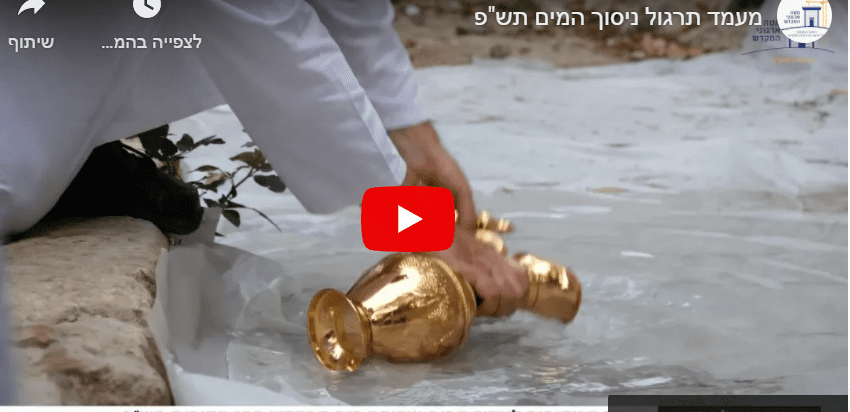Prayers of rain have been answered and after experiencing more than six years of drought, ancient sources of water are flowing in Israel. Most notably, the Shiloach Pool in Jerusalem is overflowing.
Six years of drought ended last winter with a blessed rainy season. Israel is an arid country with about 70 percent of the average rain falling between November and March and the last two years filled the Kinneret to within 12 centimeters of being full. Rain in Israel is a reflection of the relationship between the Jews and God.
Nowhere is this more evident than at the Shiloach Pool that once served the Temples in Jerusalem. On Sukkoth 18 months ago, a grand procession of Kohanim (priests), Levites, and Jews joyously descended from the Old City in Jerusalem to the Shiloach Pool in a reenactment of the Nisuch Hamayim (water libation ceremony) performed in the Temples. Upon arriving at the pool, they were dismayed to discover that there was barely enough water to fill the golden vessel.
This stands in stark contrast to the overflowing spring Israel365 reporter Joshua Wander encountered when he visited the pool on Tuesday. Wander is no stranger to the Shiloach Pool which is quite near his home on the Mount of Olives. But he was overcome with joy when he saw the spring was overflowing to an extent he hadn’t witnessed in many years.
Wander noted that the flowing abundance fulfilled a Biblical promise that the year before the Shemittah (sabbatical year) would yield bounteous crops.
And should you ask, “What are we to eat in the seventh year, if we may neither sow nor gather in our crops?” I will ordain My blessing for you in the sixth year, so that it shall yield a crop sufficient for three years. Leviticus 25:20-21
The Shemitah comes every seven years, making it a form of Sabbath that occurs on a yearly, rather than a weekly, cycle. The land is worked for six years, and on the seventh, it is left fallow and the fields are left open for anyone to come and take of the fruit.
The next year on the Hebrew calendar, 5782, beginning on September 3, begins the next Shemitah year.
The shortcode is missing a valid Donation Form ID attribute.
It should be noted that the year after Shemitah is auspicious for the arrival of the Messiah. The Babylonian Talmud in the Tractate of Sanhedrin, 97a, brings the verse from Amos:
“On that day, will I raise up the fallen booth (Sukkah) of David.”Amos 9:11
This verse comes in the context of a prophecy about God bringing the nation of Israel back from exile among the nations. Amidst descriptions of the days preceding the Messiah, the Talmud says:
“As it is written, in that day I will raise up the tabernacle of David that is fallen. Our Rabbis taught: in the seven-year cycle at the end of which the son of David will come-in the first year, this verse will be fulfilled.”
The Talmud is stating explicitly that the Messiah will come in the first year after the Shemitah. It should be noted that the Talmud describes the days before the Messiah in-depth, and they are especially difficult times.
The Shiloach Pool (Siloam in English, Silwan in Arabic) has a huge Biblical import that will re-emerge when the Third Temple is built. The Pool of Siloam was the starting point for pilgrims who made the annual pilgrimage to Jerusalem for the Biblical feasts. They would use the pool to wash and ritually purify themselves before ascending by foot to the inner court of the Temple Mount to bring their sacrificial offerings. Located outside the walls of the Old City of Jerusalem to the southeast, the pool is fed by the waters of the Gihon Spring which are carried there by the Siloam Tunnel, also known as Hezekiah’s Tunnel. Sometimes referred to in the Bible as the Lower Pool, the pool was built during the reign of Hezekiah (715–687 BCE) to replace an older Canaanite tunnel, known Biblically as the Upper Pool, that was vulnerable to attackers. The new pool and tunnel left besieging armies without access to the spring’s waters. Archeologists believe that during the Second Temple Era the waters continued to flow south and were collected in an additional, larger pool. This pool was discovered during the summer of 2004 and is continuing to be uncovered today.
The pool played a central role in the water libation offered during the holiday of Sukkoth. Though not explicitly mandated in the Torah, water libation is part of the oral tradition passed down from Moses. Throughout the year, the daily offerings in the Temple were accompanied by the pouring of wine on the altar. On Sukkot, water was poured in addition to the wine.
Sukkot is described in Jewish tradition as a joyous holiday and the water libation was the focal point of this joy.
“He who has not seen the rejoicing at the Simchat Bet Hasheavah [the water drawing ceremony], has never seen rejoicing in his life” (The Mishna, Sukkah 5:1).
The Kohen Gadol (high priest) would lead the priests and Levites from the Temple to the pool. The people would follow, singing and playing musical instruments. Upon arriving at the spring, the Kohen Gadol filled a golden vessel with water from the pool.
In Temple times, the ceremony would take fifteen hours with accompanying celebrations lasting all night until the Temple service began again the next morning. Nations came from around the world to take part in the Sukkoth celebrations making it international worship of God.
The shortcode is missing a valid Donation Form ID attribute.




